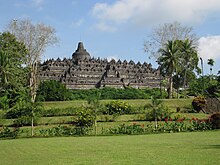Borobudur
Borobudur, also transcribed Barabudur, is a 7th-century Mahayana Buddhist temple in Magelang Regency, not far from the town of Muntilan, in Central Java, Indonesia. It is the world's largest Buddhist temple. The temple consists of nine stacked platforms, six square and three circular, topped by a central dome. It is decorated with 2,672 relief panels and 504 Buddha statues. The central dome is surrounded by 72 Buddha statues, each seated inside a perforated stupa.

Built in the 9th century during the reign of the Sailendra Dynasty, the temple design follows Javanese Buddhist architecture, which blends the Indonesian indigenous tradition of ancestor worship and the Buddhist concept of attaining Nirvana. The temple demonstrates the influences of Gupta art that reflects India's influence on the region, yet there are enough indigenous scenes and elements incorporated to make Borobudur uniquely Indonesian. The monument is a shrine to the Buddha and a place for Buddhist pilgrimage.
Quotes
edit- Strange to say, the greatest of Buddhist temples—some students would call it the greatest of all temples anywhere—is not in India but in Java. In the eighth century the Shailendra dynasty of Sumatra conquered Java, established Buddhism as the official religion, and financed the building of the massive fane of Borobudur (i.e., “Many Buddhas”). The temple proper is of moderate size, and of peculiar design—a small domical stupa surrounded by seventy-two smaller topes arranged about it in concentric circles. If this were all, Borobudur would be nothing; what constitutes the grandeur of the structure is the pedestal, four hundred feet square, an immense mastaba in seven receding stages. At every turn there are niches for statuary; 436 times the sculptors of Borobudur thought fit to carve the figure of Buddha. Still discontent, they cut into the walls of the stages three miles of bas-reliefs, depicting the legendary birth, youth and enlightenment of the Master, and with such skill that these reliefs are among the finest in Asia. With this powerful Buddhist shrine, and the Brahmanical temples nearby at Prambanam, Javanese architecture reached its zenith, and quickly decayed. The island became for a time a maritime power, rose to wealth and luxury, and supported many poets. But in 1479 the Moslems began to people this tropical Paradise, and from that time it produced no art of consequence. The Dutch pounced upon it in 1595, and consumed it, province by province during the following century, until their control was complete.
- Will Durant, Our Oriental heritage
- During his brief governorship of Java, Stamford Raffles was responsible for ordering the excavations of the spectacular Buddhist site of Borobudur: "From local Muslim records, [Raffles] established that Islam had effectively obliterated Buddhism on the island in the thirteenth century."
- quoted in Ibn, W. (2009). Defending the West: A critique of Edward Said's Orientalism. Amherst, N.Y: Prometheus Books.
- Borobudur Temple was built with an overwhelming mass of images and more than 1,400 narrative relief illustrating the life of Buddha and Buddhist texts.